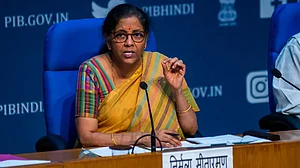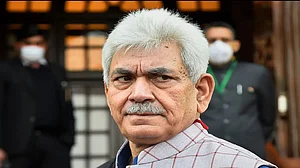
Name: Indian Government
The Government of India, officially known as the Union Government or Central Government, is the national authority of the Republic of India. India is a federal republic in South Asia with 28 states and eight union territories. The government is based in New Delhi and consists of three branches: legislative, executive, and judiciary.
The legislative branch is represented by the Parliament, which has two houses: the Rajya Sabha (upper house) and the Lok Sabha (lower house). The Rajya Sabha includes members appointed by the president and elected by state and territorial legislatures. The Lok Sabha consists of elected members. Parliament's powers are subject to judicial review by the Supreme Court.
The executive branch is led by the President of India, who has constitutional powers exercised directly or through subordinate officers. The President acts on advice from the Prime Minister, who leads the Council of Ministers. The Council of Ministers remains in power during the President's pleasure but must maintain support from the Lok Sabha.
The President appoints high officials including state governors, Supreme Court and High Court judges, the Attorney General, Comptroller and Auditor General, Election Commissioners, and ambassadors. The President is the commander-in-chief of the Indian Armed Forces and can grant pardons or reduce sentences.
The Vice President is the second-highest constitutional position, representing the nation in the President's absence and serving as chairman of the Rajya Sabha. The Prime Minister is the chief executive, leader of the majority party in the Lok Sabha, and head of the executive branch.
The Union Council of Ministers includes the Prime Minister, Cabinet Ministers, and Ministers of State. Each minister must be a member of Parliament. The cabinet is headed by the Prime Minister and advised by the Cabinet Secretary, who also leads the Indian Administrative Service.
Secretaries to the Government of India, typically Indian Administrative Service officers, are administrative heads of ministries or departments and principal advisers to ministers. They are assisted by additional secretaries, joint secretaries, directors, deputy secretaries, and under secretaries.
The judiciary includes the Supreme Court, High Courts, and district courts. The Supreme Court is the highest judicial forum and final court of appeal, with powers of constitutional review. It consists of the Chief Justice of India and other judges, hearing appeals against verdicts of lower courts and settling disputes between governments.
Elections in India involve voting at union, state, and local levels. The Prime Minister is appointed by the President from the party or coalition with a majority in the Lok Sabha. Lok Sabha members are directly elected for five-year terms. Rajya Sabha members are elected by state legislative assemblies, except for 12 nominated members.
India has a quasi-federal system with elected officials at union, state, and local levels. States are governed by Chief Ministers. State legislatures are bicameral in five states and unicameral in others. Local governments include panchayats in rural areas and municipalities in urban areas.
India's tax structure has three tiers: union, state, and local. The union government levies income tax, capital transaction taxes, sales tax, service tax, customs, and excise duties. State governments levy sales tax on intrastate goods, entertainment and profession taxes, excise on alcohol, and stamp duties. Local governments levy property tax and charge for public utilities.
The Finance Minister presents the annual union budget in Parliament. The budget must be passed by the Lok Sabha before taking effect on April 1, the start of India's fiscal year. The budget is preceded by an economic survey outlining its direction and the country's economic performance.
India faces challenges related to corruption. In 2009, several ministers were accused of corruption, and many elected members of parliament had been charged with crimes. Major scandals since 2010 have involved high-level government officials, including cabinet ministers and chief ministers.
The Government of India operates under a framework established by the Constitution of India. It follows a parliamentary system with separation of powers between the executive, legislature, and judiciary. The President is the head of state, while the Prime Minister is the head of government and leader of the executive branch.
The Parliament of India is bicameral, consisting of the Rajya Sabha and Lok Sabha. The Rajya Sabha represents the states and union territories, while the Lok Sabha represents the people of India. The Parliament has the power to make laws, control the executive, and oversee national finances.
The executive branch is responsible for implementing laws and policies. The President of India, though largely a ceremonial figure, has significant powers including the ability to declare emergencies, grant pardons, and make key appointments. The Prime Minister and Council of Ministers are the real executive power, responsible for the day-to-day governance of the country.
The judiciary, headed by the Supreme Court, is independent of the executive and legislature. It interprets the Constitution, settles disputes between various governments, and protects fundamental rights of citizens. The Supreme Court has the power of judicial review over legislative and executive actions.
India's federal structure divides powers between the Union and State governments. The Constitution provides for a division of powers through Union, State, and Concurrent lists. The Union government has exclusive powers in areas like defense, foreign affairs, and currency, while states have powers in areas like law and order, agriculture, and public health. Both share powers in areas like education and forest conservation.
The civil services play a crucial role in implementing government policies. The Indian Administrative Service (IAS), Indian Foreign Service (IFS), and Indian Police Service (IPS) are the premier civil services. These services are recruited through competitive examinations conducted by the Union Public Service Commission.
India's electoral system is based on universal adult suffrage. The Election Commission of India, an autonomous body, is responsible for conducting free and fair elections. Elections are held for the Parliament, State Legislatures, and local bodies. The first-past-the-post voting system is used for most elections.
Defense and internal security are major responsibilities of the Union government. The Prime Minister chairs the Cabinet Committee on Security, which oversees defense, foreign affairs, and internal security matters. The armed forces are under civilian control, with the President as supreme commander and the Defense Minister responsible for defense policy.
India's fiscal policy is managed by the Ministry of Finance. The Reserve Bank of India, the country's central bank, is responsible for monetary policy and regulation of the financial system. The government's fiscal policies aim to promote economic growth, control inflation, and reduce poverty.
The government has initiated various programs for social welfare and development. These include schemes for rural employment, food security, education, healthcare, and financial inclusion. The implementation of these programs involves coordination between Union and State governments.
Science and technology development is another focus area. The government supports research and development through various institutions and programs. Space research, atomic energy, and information technology are areas where India has made significant progress.
The government also plays a role in promoting India's cultural heritage and diversity. The Ministry of Culture implements various schemes for preservation of cultural sites, promotion of arts, and cultural exchanges.
In summary, the Government of India operates a complex system of governance, balancing the needs of a diverse and populous nation with the challenges of development, security, and global engagement. Its structure and functions continue to evolve to meet the changing needs of the country and its people.
























